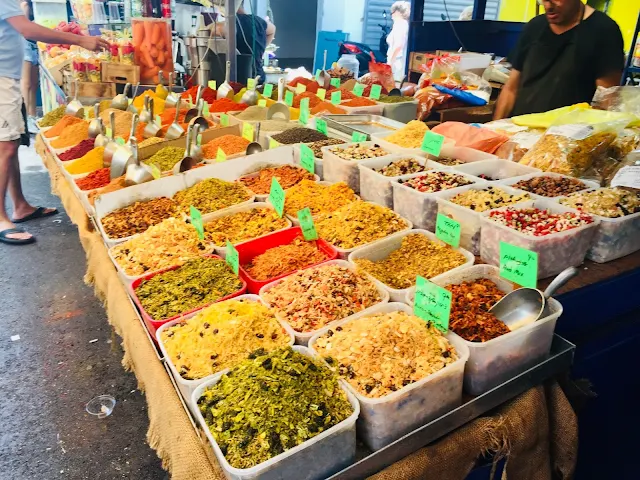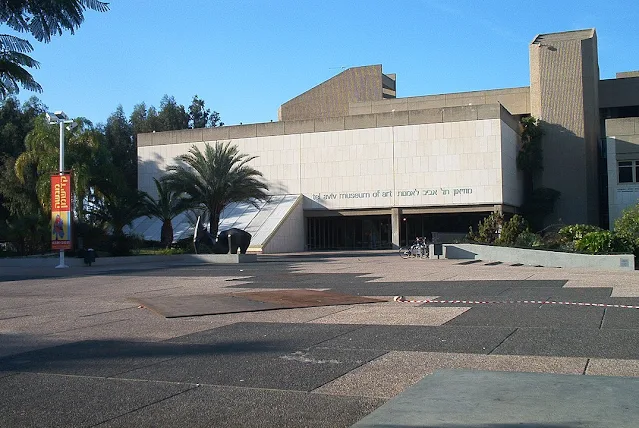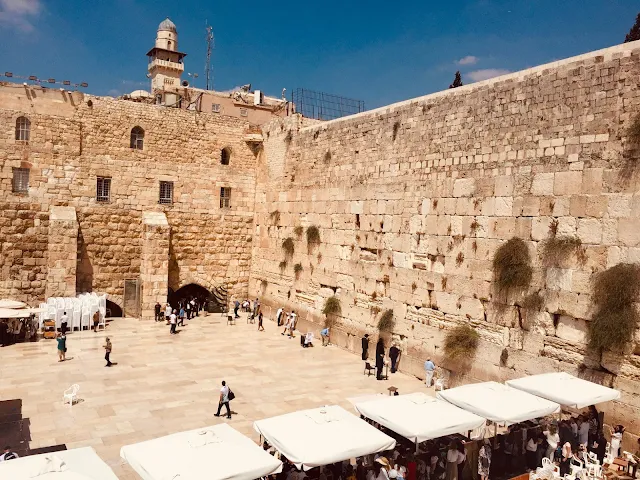Here’s a suggested itinerary for a week in Israel that includes Tel Aviv, Jerusalem, the Dead Sea, and Masada.
Why Travel To Israel
- Fascinating history
- Ancient religious sites
- Lovely beaches
- Floating experience in the Dead Sea
- Vibrant night-life
- Diverse scenery
- Year-round bright and sunny days
- Delicious local cuisine
Best Time To Visit Israel
Generally the best time to visit Israel is spring (March - May) and autumn (September - November), when it is not too crowded and the temperatures are mild.
Israel Top Experiences
- Historic and religious sites of Jerusalem
- Magnificent ancient fortification Masada
- Floating in the Dead Sea
- Exploring colorful local markets
- Traditional Jewish Sabbath Friday night dinner
Israel Itinerary Map
 |
A:Tel-Aviv B:Jerusalem C:Masada D:Dead-Sea
|
Israel Travel Itinerary
- Day 1: Arrive in Tel Aviv
- Day 2: Explore Tel Aviv
- Day 3: Explore Tel Aviv
- Day 4: Travel to Jerusalem, Explore Jerusalem
- Day 5: Explore Jerusalem
- Day 6: Explore Jerusalem
- Day 7: Day trip to Masada & Dead Sea
- Day 8: Depart
If you've more days then you can visit Bethlehem, Nazareth, Haifa and Eiat.
Quick Note: I only recommend online travel services that I personally use and trust. This post contains affiliate links. If you click through and make a purchase, I may earn a small commission at no extra cost to you.
Day 1: Arrive In Tel Aviv
Arrive in Tel Aviv and check into your hotel. As Israel's second largest city and its economic hub, Tel Aviv has a lot to offer.
In the afternoon, take part in a guided walking tour to explore the rich history of Old Jaffa district. Jaffa is considered one of the oldest port cities in the world, with a history that spans more than 4,000 years. This part of the city is a network of narrow cobblestone streets filled with art galleries, craft shops, and charming cafés.
After the tour head to the Tel Aviv Beach for some relaxing time. You could also have a nice stroll along the shoreline. End your day with a delicious dinner at one of the lovely Israeli restaurants nearby.
Best area to stay in Tel Aviv: Best location to book your stay in Tel Aviv is the City Center area.
 |
| The Clock Tower (Tel Aviv) |
 |
| Old Jaffa (Tel Aviv) |
 |
| Tel Aviv Beach |
- After a restful night and a nice breakfast, begin your day by exploring the Carmel Market. As the largest market in Tel Aviv, it’s full of lively stalls and vendors who sell everything from dried fruits and exotic spices to clothing and footwear. The market's sights, smells and sounds will awaken your senses. Then have a nice lunch at one of the traditional Israeli restaurants nearby.
- After lunch head to the charming neighborhood of Neve Tzedek. This area has many cafes, ice-cream shops, craft shops, fragrance shops, etc. After you've checked out the lovely shops, find a spot relax and enjoy a cup of coffee or a delicious ice-cream.
- In late afternoon head to the beach again for some relaxing time. End your day again with a delicious dinner at one of the lovely restaurants nearby.
 |
| Carmel Market (Tel Aviv) |
 |
| Carmel Market (Tel Aviv) |
Day 3: Explore Tel Aviv
- Begin your day by exploring the Tel Aviv Museum of Art. This museum features an extensive collection of both classical and contemporary Israeli art. The museum also features a collection of European art spanning from the 16th to the 19th century. There are also dedicated galleries for photography, graphic arts, and industrial design.
- Then head to Sarona Market for a nice lunch. This is Israel's biggest indoor culinary market, with a variety of retail shops, food stalls, and restaurants. After you've enjoyed your meal, take some time to wander around and discover all that Sarona Market has to offer.
- Next, make your way to Rothschild Boulevard. Stroll down this lively street, which is famous for its stunning Bauhaus buildings, charming cafes, and lively bars. While you are there, enjoy a cup of coffee or a refreshing cocktail.
 |
| Tel Aviv Museum Of Art |
(Above Image By Itayba at Hebrew Wikipedia - Transferred from he.wikipedia to Commons., Public Domain, https://commons.wikimedia.org/w/index.php?curid=3289896)
 |
| Rothschild Boulevard (Tel Aviv) |
Day 4: Tel Aviv to Jerusalem, Explore Jerusalem
Travel from Tel Aviv to Jerusalem, which takes roughly an hour by road. Jerusalem is one of the oldest cities in the world. In the afternoon, participate in a guided walking tour of the Old City, exploring all four quarters: Jewish, Muslim, Christian, and Armenian.
Best areas to stay in Jerusalem: Best location to book your stay in Jerusalem is the Old City or West Jerusalem area.
 |
| Jerusalem Old City |
Day 5: Explore Jerusalem
- Begin your day with a visit to The Church of the Holy Sepulchre, an incredible church dating back to the fourth century, located in the Christian Quarter of Jerusalem's Old City. This church serves as the headquarters for the Greek Orthodox Patriarchate of Jerusalem. Many regard it as the most sacred site in Christianity, and it has been a significant destination for Christian pilgrims since its establishment in the fourth century.
- In the afternoon visit Mount of Olives which is a mountain ridge named for the olive groves that once covered its slopes. The Mount of Olives has been used as a Jewish burial cemetery for over 3,000 years, with around 150,000 tombs, making it one of the oldest and most significant Jewish cemeteries. It also holds great importance in Christianity, as Jesus frequently visited this area to teach and pray. From the Mount of Olives, you can enjoy breathtaking panoramic views of the Old City of Jerusalem and the iconic Dome of the Rock. It is located about 826 meters (2,710 feet) above sea level and is separated from the city by the Kidron Valley.
- Then visit the Tomb of the Virgin Mary at the foot of Mount of Olives, believed by Christians to be the burial place of Mary. The present church and tomb date back to the sixth century. The tomb is situated in a modest, dimly lighted, and peaceful chamber.
 |
| Church of the Holy Sepulchre (Jerusalem) |
 |
| Mount of Olives (Jerusalem) |
 |
| Tomb of the Virgin Mary (Jerusalem) |
Day 6: Explore Jerusalem
- Begin your day by visiting The Western Wall which is one of the most significant religious and historical sites in Jerusalem, deeply revered by Jews, and also holding significance for Christians and Muslims. This wall is a part of the old retaining structure of the Second Temple, which formerly stood on the Temple Mount.
- In the afternoon visit Temple Mount which is one of the holiest sites in Jerusalem. This place holds great significance for Judaism, Islam, and Christianity. For Jews, it is regarded as the holiest location, believed to be where the two ancient Temples once stood. The Temple Mount is also the location of the Al-Aqsa Mosque and the Dome of the Rock, ranking as the third most sacred site in Islam, following Mecca and Medina. For Christians this place is not the primary site of worship, but its biblical links make it significant. Don’t forget to check the visiting hours for Temple Mount before your visit.
- In late afternoon visit Mahane Yehuda Market which is a lively marketplace with vendors selling everything from souvenirs to aromatic spices. The roots of the market trace back to the late 1800s, when Arab and Jewish vendors first began selling their produce. With time, it has evolved into a vital and iconic part of the cultural scene in Jerusalem. In the evening, the market becomes a lively gathering place for people to connect and socialize. End your day with dinner at one of the many dining options in the market.
 |
| The Western Wall (Jerusalem) |
 |
| The Western Wall (Jerusalem) |
 |
| Temple Mount (Jerusalem) |
 |
| Mahane Yehuda Market (Jerusalem) |
Day 7: Day trip to Masada & Dead Sea
- Join Masada and Dead Sea Day Tour from Jerusalem. Alternatively you could rent a car or take the bus from Jerusalem to visit Masada and Dead Sea.
- In the morning visit Masada which is an ancient fortification built in the year 30 BCE by King Herod and is situated on top of a rock plateau. It is an archaeological site that houses the remains of a Sicarii settlement. Masada was declared a UNESCO World Heritage Site in 2001 for its historical and cultural importance. It is a national symbol of Jewish heroism and perseverance. Use the cable car for easier and faster way to reach to the top
- In the afternoon, make your way to the Dead Sea for a bit of relaxation. As the lowest point on Earth, the Dead Sea offers a unique experience where the high salt content allows you to float with ease. One great place to enjoy this is at Ein Bokek beach.
 |
| Dead Sea |
 |
| Masada |
 |
| Masada Cable Car |
What To Shop In Israel
Israel is known for spices, Halva (dessert), Dead Sea skin products, Eilat stone, jewelry and Armenian pottery.
Foods To Try In Israel
- Hummus
- Baba Ganoush
- Tahini
- Falafel
- Shawarma
- Sabich (Israeli sandwich)
- Shakshouka (eggs poached in tomato sauce)
- Israeli salad
- Israeli breakfast
- Lahoh (spongy bread)
- Halva
- Bourekas (pastry)
- Kanafeh (pastry)
 |
Israeli Halva |
(Image by Paulina Zet _ Vered Hasharon - DSC_0764, CC BY 2.0, https://commons.wikimedia.org/w/index.php?curid=384359)
I’d love to hear your thoughts on this itinerary! Feel free to share your questions or suggestions in the comments section below.























No comments:
Post a Comment